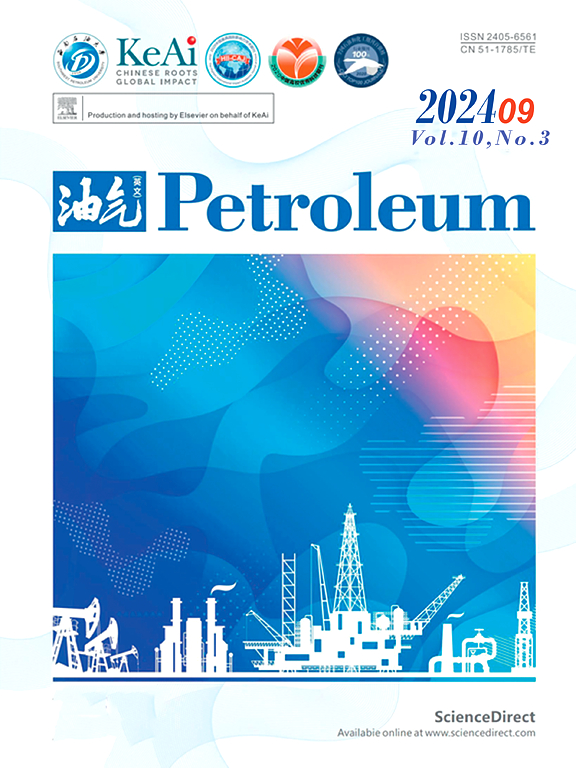Using ultrasonic and microwave to prevent and reduce wax deposition in oil production
IF 4.2
Q2 ENERGY & FUELS
引用次数: 0
Abstract
Wax deposition in oil and gas pipelines and equipment is a fundamental challenge that can lead to a decrease in the performance and useful life of these systems. To address this issue, various methods have been developed to reduce wax deposition. This article investigates two novel methods, namely microwave and ultrasonic, for wax deposition mitigation. The microwave method utilizes high-frequency electromagnetic waves and short wavelengths to transfer heat to the wax and separate it from the internal surface of the pipelines. In this method, microwave waves provide energy to the wax, increasing its temperature and causing it to melt and move. Due to its speed, efficiency, and applicability in industrial environments, the microwave method has been recognized as a leading approach in wax deposition reduction, requiring minimal modifications to the pipeline structure. The ultrasonic method employs high-frequency sound waves to disrupt and prevent wax deposition. Ultrasonic waves generate alternating pressure waves at the site of wax accumulation, breaking down the wax structure. This non-destructive and reliable method is capable of reducing wax deposition in hard-to-reach areas. Both microwave and ultrasonic methods have gained attention as innovative approaches for wax deposition reduction. However, further research is needed to optimize and enhance these methods, aiming to improve their implementation capabilities, increase efficiency, and reduce costs. The study also addressed conventional and common methods, such as insulators heat-proofing materials, heating techniques to prevent wax deposition, cold flow, wax inhibiting tools, wax removal techniques, chemicals, and bacterial treatment.
利用超声波和微波防止和减少石油生产中的蜡沉积
石油和天然气管道和设备中的蜡沉积是一个根本性的挑战,可能导致这些系统的性能和使用寿命下降。为了解决这个问题,已经开发了各种方法来减少蜡沉积。本文研究了微波和超声波两种新型的蜡沉积减缓方法。微波法利用高频电磁波和短波将热量传递给蜡,并将其与管道内表面分离。在这种方法中,微波为蜡提供能量,提高其温度,使其融化和移动。由于其速度、效率和在工业环境中的适用性,微波方法已被认为是减少蜡沉积的主要方法,需要对管道结构进行最小的修改。超声波法利用高频声波来破坏和防止蜡沉积。超声波在蜡堆积的部位产生交替的压力波,破坏蜡的结构。这种非破坏性和可靠的方法能够减少蜡沉积在难以到达的区域。微波法和超声波法作为减少蜡沉积的创新方法受到了人们的关注。然而,这些方法需要进一步的研究来优化和增强,以提高其实施能力,提高效率,降低成本。该研究还讨论了常规和常见的方法,如绝缘体隔热材料、防止蜡沉积的加热技术、冷流、蜡抑制工具、蜡去除技术、化学品和细菌处理。
本文章由计算机程序翻译,如有差异,请以英文原文为准。
求助全文
约1分钟内获得全文
求助全文
来源期刊

Petroleum
Earth and Planetary Sciences-Geology
CiteScore
9.20
自引率
0.00%
发文量
76
审稿时长
124 days
期刊介绍:
Examples of appropriate topical areas that will be considered include the following: 1.comprehensive research on oil and gas reservoir (reservoir geology): -geological basis of oil and gas reservoirs -reservoir geochemistry -reservoir formation mechanism -reservoir identification methods and techniques 2.kinetics of oil and gas basins and analyses of potential oil and gas resources: -fine description factors of hydrocarbon accumulation -mechanism analysis on recovery and dynamic accumulation process -relationship between accumulation factors and the accumulation process -analysis of oil and gas potential resource 3.theories and methods for complex reservoir geophysical prospecting: -geophysical basis of deep geologic structures and background of hydrocarbon occurrence -geophysical prediction of deep and complex reservoirs -physical test analyses and numerical simulations of reservoir rocks -anisotropic medium seismic imaging theory and new technology for multiwave seismic exploration -o theories and methods for reservoir fluid geophysical identification and prediction 4.theories, methods, technology, and design for complex reservoir development: -reservoir percolation theory and application technology -field development theories and methods -theory and technology for enhancing recovery efficiency 5.working liquid for oil and gas wells and reservoir protection technology: -working chemicals and mechanics for oil and gas wells -reservoir protection technology 6.new techniques and technologies for oil and gas drilling and production: -under-balanced drilling/gas drilling -special-track well drilling -cementing and completion of oil and gas wells -engineering safety applications for oil and gas wells -new technology of fracture acidizing
 求助内容:
求助内容: 应助结果提醒方式:
应助结果提醒方式:


